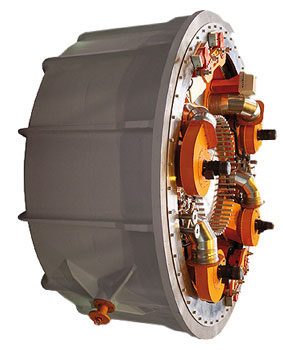
The Switch’s low-speed, direct-drive permanent magnet generators, PMG 1,650 to 6,300 kW, 11 to 17 rpm, operate without a gearbox and its fast-rotating parts. A typical speed range is 10 to 20 rpm.
By Carlo Cecchi, Director of Business Development at The Switch
Chinese companies have been stepping up their global investment spree in the past 12 months.
Mergers and acquisitions (M&As) by private companies are becoming the key drivers of China’s outbound direct investment. Following an edict laid down by the government as part of its five-year plan of 2011, Chinese firms have been acquiring advanced technology and high-quality brands from abroad.
M&As are attractive because there are lots of businesses undergoing cheap privatizations. Cash-strapped firms and a weak euro also provide Chinese companies with ample opportunities. So, M&As have become the fastest way for Chinese firms to tap into foreign markets.
Until recently, most outbound deal-making was by state firms buying up raw materials. Now, high value-added businesses are the main target and private capital is flowing. In 2014, Chinese companies accounted for 41% of the total deal value.
Many of the technologically progressive businesses that Chinese firms are targeting are in the wind and marine sectors. If the firms are choosing smartly, they will be looking out for businesses that use permanent magnet (PM) technology. Generators using PM technology have been proven to be far more effective than those using double-fed technology, thanks to its unrivaled advantages of operational performance, cost efficiency and annual power output.
Is the Chinese M&A model enough to secure the use of permanent magnet technology?
Of course not!
Acquiring technological value-added assets is likely to remain extremely difficult. Chinese companies are still not well understood overseas. The management has not yet acquired sufficient skills, and cultural integration can be a challenge. The easy access to money has generated an extremely arrogant market approach by state-owned enterprises (SOE), which is also reflected in domestic transactions with foreign companies.
Buying a company does not guarantee technological progress. M&As do not guarantee the development of new products, nor will they upgrade the existing ones to fit in with the latest technological trends.
This situation is evident in China today, where there has been no clear technological breakthroughs made in the marine and wind industry, despite the fact that huge investments and acquisitions have occurred in both sectors.
How can we solve the problem?
Here is a checklist for success:
- Stop the arrogant “can do” approach that is typical of Chinese SOEs
- Remember that free access to overseas markets doesn’t mean free access to technology
- Be a pioneer in new technology
- Select the correct partner – one who really owns the technology
- Develop long-term, smart market-oriented partnerships with foreign companies that are based on mutual trust and a share in the risk and profit
- Use license agreements to secure new product developments. Use your local assets (factories and supply chains) with clear targets, planning, and fair remuneration of the development costs
- Develop a clear after-sales-service strategy
The Switch, with an 11 GW installed base, is the natural partner of choice for PM technology. Partly due to its flexible business model, The Switch is able to support complete assembled machines. The company can also license products to any partner that is willing to help pioneer new technology in marine, renewable energy, combined heat and power, or industrial applications.
The advantages of PM technology are widely documented. Still, there is a more intangible asset that also comes by partnering with The Switch, namely, the possibility of gaining access to state-of-the-art technology. This partnership could help Chinese companies bridge the technological gap and get rid of any doubt that still remains about Chinese quality and reliability.
The Switch
www.theswitch.com/
Filed Under: News, Policy, Turbines




